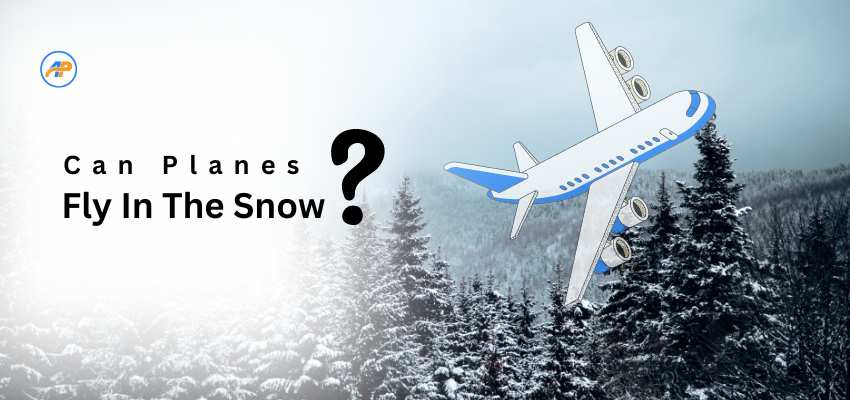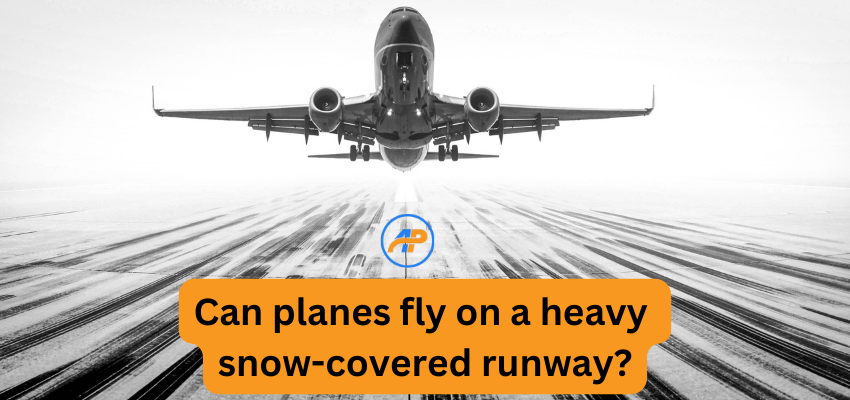
There are concerns about flight operations during extreme weather conditions, especially during winters. The question arises is – can planes fly in the snow? Due to snowstorms and icy conditions, there are questions raised on aircraft maintenance from the safety perspective!

Travel enthusiasts must know that aircrafts are ergonomically designed to handle tough weather conditions, including snowstorms, torrential rains, etc. Plus, there are safety protocols in place that guarantee a secure journey.
There are advancements in aviation technology and pilot’s expertise that help maintain flight safety, no matter how adverse the weather is. For instance, the coordination between air traffic controllers, airport staff, and pilots ensures that the runway is clear and visibility is sufficient for flying.
The aviation industry is strictly regulated with the focus mainly on safety. When waiting to board your flight amidst a snowstorm, you can trust the pilots and the airport management who work diligently to ensure that your journey is secure and comfortable.
Also Read: Will Spray Sunscreen Explode On A Plane?
Can planes fly in heavy snow?
Natural weather conditions exist, but can planes fly in snow? Today, the modern aviation industry has deployed relevant strategies to tackle this challenge. Here are the factors that help sustain aircraft in snowy conditions –
There are safety systems in place to ensure passengers’ well-being. For example,
- Pilots are well equipped to use the advanced radar system. This offers the real time updates and helps me make the necessary maneuvers to the aircraft.
- Anti-icing technology that helps remove ice on the outer parts of the aircrafts.
Also Read: Can you bring a curling iron on a plane?
There are other measures in place, that help smooth flight operations –
- De-icing procedures to eliminate ice and snow from the ground.
- Extensive drill by the crew members to keep the operations secure and smooth.
- The aviation professional prioritizes safety. They actively manage runway operations in snowy conditions, adjusting takeoff and landing schedules to maintain safe separations between flights.
Also Read: Can You Bring A Hair Dryer On A Plane?
The science behind de-icing: Why does it take so long
We love to share our time with family and friends. But to snowstorms, the flight delays are bound to happen.
Your urgency while traveling in the snow is no doubt of paramount importance, but de-icing is necessary and it may require you to wait at the gate considering how eager you are to reach your destination.
Also Read: Can You Change The Name On A Plane Ticket?
Can planes fly in 3 inches of snow at the runway?

History has shown us instances where shortcuts taken by the pilots or airport authority to save time have resulted in unfavorable consequences.
Let’s understand why icing takes so long.
Now you have got the answer to your question – can planes fly in snow? Let’s understand how aircrafts run their smooth operations.
Aircraft can be de-iced either with engines shut down at the gate or in the hangar, depending on the available facilities at certain airports. Some airports face snow and ice conditions and have relevant facilities. One such is Vancouver International Airport (YVR). On the other hand, airports like John F Kennedy Airport (JFK) in New York rely on gate de-icing trucks.
Not all airports invest in de-icing infrastructure. The answer also lies in the seasonal occurrence of snowfall, especially in the United States and Canada. The airports in these countries have cost as well as space constraints. It is always a situation of ambiguity for the airport authorities whether to spend millions on cutting-edge technology or simply deploy a handful of labor with shovels.
Also Read: How Can You Take Flowers On A Plane?
How long does the de-icing take?
This de-icing takes from a few minutes to 1 hour, depending on the snow accumulation on the aircraft or runway. With sizeable de-icing trucks, the flights are inevitable.
Throughout this process, the most uphill task for the crew is to remain composed and maintain the decorum. During de-icing certain procedures can’t be completed in a jiffy.
Also Read: Can you bring dry shampoo on a plane?
De-icing is the potential cause of delta and flight cancellations.
After the de-icing, if the snow continues to fall, there’s a holdover time that helps maintain the air temperature and precipitation, before the snow starts accumulating on the aircraft wings. It may cause more delays, resulting in frustration for the passengers.
Rest assured, the airline and the airport staff are always committed to ensuring your safety and comfort throughout the process.
Can planes fly on a heavy snow-covered runway?

Can planes fly in snow especially when there’s a thick ice layer on the runway? During snowstorms, as you approach the runway, the attention intensifies. Pilots carefully listen to the Air Traffic Control (ATC) instructions, especially when the visibility is compromised due to fog or snow.
In such cases, the ATC instructions are crucial, which emphasizes the importance of using the English language, which is the official language for ATC instructions. This lingual consistency is very important in building the mental map of nearby aircraft, whether they’re landing or taking off along the runway.
Also Read: Can you bring dry shampoo on a plane?
ATC offers real-time status!
ATC not only gives instructions but also offers real-time status about the runway conditions. Flight departure from thick-covered snow is possible, considering the other risks like slipperiness and the accumulated snow. Also, the snow varies in wetness and is majorly influenced by the air temperature.
In North American and Scandinavian countries where snow is thick-layered and often dry, visibility is not the challenge, thanks to the persistent effort by the ATC staff.
Airport Authority is well equipped with state-of-art infrastructure
Also, the airport authority in these countries deploys specialized rollers vehicles that assess the slipperiness. With this furnished information, the review data to calculate the performance for take-off and landing.
To be aware, wetter snow is a very common occurrence during snowstorms and makes the runway more slippery. In those cases, the airport authority very much relies on anti-icing treatment, which may cause flight delays, but prioritizes safety.
Before take off, the pilots assess the weather conditions to ensure that the previous performance metrics remain valid. If conditions worsens, they have to recalculate to introduce new metrics. Only when the pilots are confident that the aircraft is free from snow, and the performance metrics are favorable for take off, then only pilots inform ATC about the readiness of departure.
The Influence of Cold Weather on Aircraft

To start with, the pilot visibility is the topmost priority for safe flight operations, especially during take-offs and landing. Snowy weather may hamper visibility, posing challenges for pilots. Modern aircrafts are equipped with advanced instruments that assist with navigation in low or poor visibility conditions.
Cold temperatures also bring the risk of ice accumulation on the aircraft’s wings and outer parts. This ice formation may disrupt the aircraft’s lift generation, thus impacting the overall performance.
Therefore, it is important to execute the de-icing process before taking off in any harsh weather conditions. This process involves applying chemicals to the aircraft that eliminates ice and its formation during flight.
Snowstorm is a big concern
The snowstorms are the main reason behind delays at airports combined by other factors like high winds, poor visibility and snowfall volume that affect air traffic control and other essential operations.
Modern aircrafts are well equipped to handle cold and snowy conditions, but it is the de-icing process that extends passengers’ travel timeline.
Furthermore, winter storms bring concerns about high winds. It may cause turbulence, potentially causing discomfort to the passengers. Rest assured, in these challenging conditions, pilots are well-trained to manage such situations.
Conclusion
Can a plane fly in the snow? Planes do fly in snowy conditions. It may pose certain challenges, but it is not a major task for pilots and ground crew.
Frequently Asked Questions (FAQs)
Can planes fly in snow?
Yes, planes can fly in snow. But the decision to take off and land in snowy conditions depends on severity of snowfall, aircraft performance and the type of aircraft.
Can a plane fly in 3 inches of snow?
Yes. Planes operate in light snow conditions like 3 inches of snow. Howvers, it rests on factors like the airport’s infrastructure, visibility and the pilot’s experience.
Can planes fly in snow storms?
Yes. Planes are equipped to handle tough weather conditions including snowstorms. But the severity of weather, and aircraft’s conditions plays a vital role.
Can planes fly in light snow?
Yes, planes operate in light snow, provided that the runway conditions must meet the safety standards.
Can small planes fly in snow?
Just like large commercial aircrafts, small planes do fly in snow but the decision depends on the aircraft’s capabilities.
Can planes fly in heavy snow?
Planes can fly in heavy snow. Airports across the globe deploys de-icing procedures. Besides, the pilot also considers visibility levels to ensure safe operations in heavy snowfall.
Can planes still fly in snow?
Planes are capable of flying in snow, provided they must adhere to the safety protocols. Airlines make informed decisions based on weather and airport’s infrastructure to ensure passenger safety and smooth flight operations.
Can planes fly in the rain?
Aircraft are perfectly adept to fly in rainy conditions. Howvers, rains are less likely to flight cancellation compared to snow or strong winds.
Can planes fly in freezing weather?
Yes, aircrafts are designed to ensure snowy conditions. Before takeoff, aircrafts diligently have to go through de-icing process to remove ice that may have accumulated.
Is it risky to fly in the winter?
No. It is generally safe but it depends on the severity of weather. Passengers should know that aircrafts and airports are well-equipped to handle tough winter conditions.
What are the chances of flight cancellation if it snows?
Flight delays or cancellations may happen during snowstorms. The decision to cancel the flight depends on its severity which prompts the airline to arrange an alternate flight for you, or potential delays.
